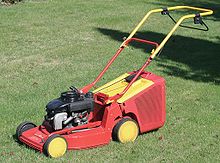Small engine
This article needs additional citations for verification. (July 2011) |


A small engine is the general term for a wide range of internal combustion engines used to power lawn mowers, generators, concrete mixers and many other machines that require independent power sources.[1] Most small engines are single-cylinder, V-twin, or flat-twin units. Although much less common, there have been small Wankel (rotary) engines manufactured for use on lawn mowers and other such equipment.[2]
The engines, which may be of two- or four-stroke design, are small in both physical dimensions and power output, relative to larger automobile engines. Power output ranges from less than 1 to about 15 horsepower. The smallest of all are used in handheld garden machinery, such as string trimmers and chainsaws, which may be as small as 25 cc (2 cu in) piston displacement. The most common are four-stroke air-cooled single-cylinder engines equipped with a carburettor and running on petrol. Engines for small machinery that must be hand-carried, such as string trimmers and chainsaws, are usually of the two-stroke design, which is lighter for any given power output. However, two-stroke engines create a relatively large amount of air pollution and noise pollution, and so are beginning to be supplanted by four-stroke units.[citation needed]
Compared to modern vehicle engines, small engines are relatively simple in design. Capital cost is usually more important than fuel economy, running costs or longevity,[citation needed] thus encouraging simple designs.
Design
Valves are most commonly OHV actuated. An example of one of the best known and most popular designs is the Honda GX range, dating from the early 1980s.[3] The sidevalve arrangement still persists, owing to its simplicity for both manufacture and basic maintenance. A few engines, such as the Honda GC series, now use overhead cam valvegear, driven by a timing belt. This engine also uses an unusual monobloc design where the cylinder head, block, and half the crankcase share the same casting, termed 'uniblock' by Honda.
Electrical systems for these engines are usually simple and minimal, mostly to avoid the need for a battery. Many uses require the engines to be ready for immediate use, even after long standby storage and the risk of a flat battery. Most small engines are equipped with capacitor discharge ignition, which—like the magneto that preceded it—is an ignition system that does not require a battery.
Electric starting is available for small engines and is found primarily on high-feature garden and snow-removal machinery, larger generators, and welders particularly where there is already a complex electrical system and there may be a need for auto-starting on demand. However, a self-retracting rope-pull mechanism called a recoil starter is the predominant method of starting small engines; it does not require a battery to power a starter motor, nor an alternator to keep the battery charged. Before the advent of the recoil starter, a notched pulley was attached to the engine's flywheel; the operator would manually wind a rope around the pulley then jerk the rope to rotate the engine so that it would start. Another starting method briefly popular in the 1960s was the "impulse" or "wind-up" starter. These were operated by winding a heavy spring by means of a rotating crank handle equipped with a sprag clutch, then releasing the spring's tension by means of a lever or knob so that it would spin the engine. These were discontinued when safety problems became apparent: it was possible to leave the starter wound up and ready to start the engine unintentionally, even long after the crank was wound up, if the release were jarred.
Fuel systems are usually simple, at least for petrol engines. The fuel tank may be placed above a float-type carburettor so that gravity is adequate to bring fuel to the carburettor, avoiding the need for a fuel pump. Alternatively, the tank may be placed below a carburettor which uses engine vacuum or crankcase pressure pulsations to lift fuel into the carburetor. Float-type carburettors can only be used when the engine is reliably vertical and without excessive vibration.
Most small engines have a governor to regulate and maintain the engine speed as constantly as possible despite changing load. Some engines also have an adjustable throttle by which the operator or the machine itself can alter the engine speed. Generally, the nominal "throttle control" does not directly control the opening of the carburetor throttle, but rather increases or decreases spring tension on the governor, which in turn regulates the engine speed higher or lower.
Small engines may be configured with the crankshaft horizontal or vertical, according to the intended application. Vertical axis engines were developed for rotary lawnmowers, but the size of this large market has encouraged a supply of cheap engines and they are now used for other purposes too, such as generators.
History

Small engines date back to the early days of internal combustion engines. The first of a recognisably modern form date from the advent of motorcycles, where the engines were made by the same manufacturers.
- Major manufacturers today
- Briggs & Stratton
- Honda
- Kawasaki
- Kohler
- Ryobi
- Subaru Industrial Power Products
- Yanmar (small diesel engines)
See also
References
- ^ Curt Choate; J.H. Haynes (1991). Small Engine Repair Manual. Haynes. ISBN 1-85010-755-6.
{{cite book}}: Invalid|ref=harv(help) - ^ "Now You Can 'Mow' with a Wankel!" Popular Science, July 1973 p. 18
- ^ "Honda GX160 engine". Honda.
